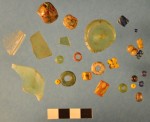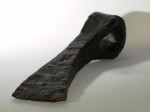According to the Royal Frankish Annals, the small port town of Sliasthorp by the Baltic Sea bay of Schlei in southern Jutland was expanded into a powerful military center by the early, possibly the first, Viking King Godfred in 808 A.D. Historians have interpreted Sliasthorp as the trading settlement of Hedeby, the largest Scandinavian city of the Viking era, or as a legend with an unknown factual basis.
 An archaeological team from Aarhus University in Denmark have found the remains of an elite Viking town near Schlei Bay that they believe is King Godfred’s Sliasthorp. It all began in 2003 when then-student archaeologist Andres Dobat decided to investigate the area near Hedeby by the Danish-German border looking for other Viking settlements. He took a metal detector to locations where Viking artifacts had been discovered before and near the Schlei Bay town Füsing, he found a gold bracelet. Other metal artifacts from the Viking Age followed indicating a possible settlement.
An archaeological team from Aarhus University in Denmark have found the remains of an elite Viking town near Schlei Bay that they believe is King Godfred’s Sliasthorp. It all began in 2003 when then-student archaeologist Andres Dobat decided to investigate the area near Hedeby by the Danish-German border looking for other Viking settlements. He took a metal detector to locations where Viking artifacts had been discovered before and near the Schlei Bay town Füsing, he found a gold bracelet. Other metal artifacts from the Viking Age followed indicating a possible settlement.
 He then had the excellent idea to fly over the area so he might be able to spot signs of Viking homes. The soil is more fertile over Viking walls, apparently, so if you see a checkerboard of taller, fuller, longer-lived crops, you could well be seeing a map of Viking settlement. Dobat took aerial pictures of cornfields which upon examination revealed the outlines of houses, probably Viking pit-houses. Archaeologists from Dobat’s school, the University of Kiel in Germany, confirmed his work using geophysical surveying tools which found there were at least 100 pit-houses under the soil.
He then had the excellent idea to fly over the area so he might be able to spot signs of Viking homes. The soil is more fertile over Viking walls, apparently, so if you see a checkerboard of taller, fuller, longer-lived crops, you could well be seeing a map of Viking settlement. Dobat took aerial pictures of cornfields which upon examination revealed the outlines of houses, probably Viking pit-houses. Archaeologists from Dobat’s school, the University of Kiel in Germany, confirmed his work using geophysical surveying tools which found there were at least 100 pit-houses under the soil.
 In 2010, Dobat, now a prehistoric archaeology professor at Aarhus University, received a grant to excavate the spot. The excavation is now in its third season and has born exceptional fruit. They have found about 200 houses filled with artifacts like beads, glass fragments, amulets, metal riding equipment, knives, axes, arrowheads and caltrops, large pointy jacks-like items that were dropped in fields to stab the feet of enemy forces.
In 2010, Dobat, now a prehistoric archaeology professor at Aarhus University, received a grant to excavate the spot. The excavation is now in its third season and has born exceptional fruit. They have found about 200 houses filled with artifacts like beads, glass fragments, amulets, metal riding equipment, knives, axes, arrowheads and caltrops, large pointy jacks-like items that were dropped in fields to stab the feet of enemy forces.
 In addition to the pit-homes, they also discovered the remains of ten smaller longhouses and one longhouse 100 feet long and 30 feet wide that had been burned down during the 10th century. The weapons found on the spot indicate it was destroyed in battle.
In addition to the pit-homes, they also discovered the remains of ten smaller longhouses and one longhouse 100 feet long and 30 feet wide that had been burned down during the 10th century. The weapons found on the spot indicate it was destroyed in battle.
The attack took place long after King Godfred’s death. But even if he had been alive, it’s still unlikely that he witnessed the attack. Back then, kings were always on the go and rarely spent long periods at Sliasthorp.
As a consequence, the daily running of the town is likely to have been administered by the town chief, who lived in the lavish longhouse. [..]
The king wasn’t the only one travelling in and out of the Viking town. The town’s population figures fluctuated several times within the same year, depending on whether there was a need for craftsmen and soldiers in the area. Only a select group of the absolute elite Vikings lived in Sliasthorp over extended periods.
Based on the industrial design and the building style, Dobat reckons that a majority of the houses in the town were only used a few weeks a year. At times there were 100 people in the town; other times perhaps over 1,000.
 The town was in use for about 300 years between approximately 700 and 1000 A.D. Dobat believes the town was an elite power center, populated by religious military leaders who would then found larger trading centers nearby. The dating supports his hypothesis. Sliasthorp was founded 100 years before Hedeby which is about three miles away. At least one other large Viking Age town, Birka, near Stockholm, seems to have been founded and run by small neighboring elite settlements, not by the merchants who would inhabit it.
The town was in use for about 300 years between approximately 700 and 1000 A.D. Dobat believes the town was an elite power center, populated by religious military leaders who would then found larger trading centers nearby. The dating supports his hypothesis. Sliasthorp was founded 100 years before Hedeby which is about three miles away. At least one other large Viking Age town, Birka, near Stockholm, seems to have been founded and run by small neighboring elite settlements, not by the merchants who would inhabit it.
Andres Dobat believes this means that the entire urban development in the northern German/southern Denmark region began with Sliasthorp.
“This is common European history. We have actually found the origins of what we today call Hamburg,” says Dobat.
“When the Vikings built this town and Hedeby, they were a precursor of Schleswig, which in the early Middle Ages was the great trading city in the region. Schleswig, in turn, was the precursor of Lübeck, which today has given way to Hamburg. We’re digging at the roots of world economy.”